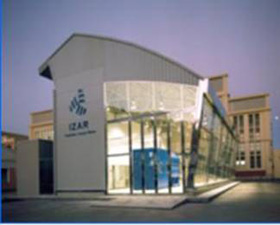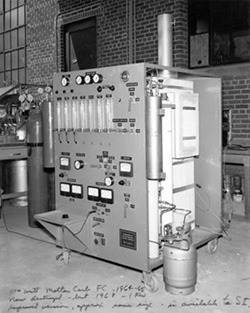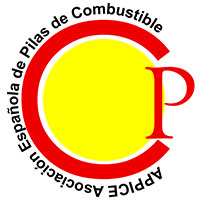MOLTEN CARBONATE FUEL CELL or MCFC

Navantia (the former IZAR) is currently carrying out a project together with MTU. The image shows an MTU module model HotModule TM 250 kW.
They use as electrolyte a molten salt of alkaline carbonates (Li, Na, K) retained in a lithium aluminate matrix. They operate at temperatures above 650 ° C, improving their performance when working under pressure. The materials commonly used as electrodes are nickel doped with chromium or aluminum for the anode, and lithium nickel oxide for the cathode, while other materials are more resistant to corrosion. They are used in stationary applications with use of the waste heat generated, their development being very advanced and soon to be commercialized. They admit high concentrations of CO and CO2 in the feed gases, which makes them suitable for the use of all types of fuels, such as natural gas, biogas, bioethanol … Carbon oxides are formed in the process of reforming these fuels, eliminating the need for their elimination as in the case of low temperature fuel cells. A further advantage is that the reforming can be carried out internally, that is, a hydrocarbon can be fed directly without the need to convert it into hydrogen.
A bit of History
In 1900, Walter Nerst investigates the potentiality of zirconium oxide as a solid electrolyte, looking for an alternative to acid electrolytes. Subsequently, the development of this technology is driven by the expectation of being able to directly use solid carbon as fuel. Baur and Preis (1937) in Switzerland proved the use of alkali carbonates as basic elements for the development of such a system, although with little success. In addition, the conductivity of the electrolyte was not sufficient to work with gaseous fuels and unwanted reactions occurred at the electrodes. Sometime later, in 1946, the Russian scientist Davtyan developed a cell that operated at 700 ° C with an ionic solid conductor as an electrolyte and during the 1940s, OKDavtyan continued research in Russia, but it was not until the decade of the 50 than the Danish GHJBroers and JAA Ketelaar leave the line of electrolytes oxides and opt for molten salts. In 1960 they report having operated a fuel cell for 6 months with an electrolyte composed of a mixture of lithium, sodium and / or potassium carbonates impregnated on a porous sintered magnesia disc.

The United States Navy also investigates this technology. The upper photo shows a 100 W power system based on MCFC technology manufactured by Texas Instruments (1966).

The upper image shows one of the modules that make up the stack of the fuel cell that incorporates this system.
In that same decade, the industrial organization Gas Technology Institute (created more than 60 years ago) begins its study in the molten carbonate fuel cells, demonstrating its capacity to generate electrical energy at high temperature. The maximum exponents in the development of this technology has been the German MTU, with its American partner, Fuel Cell Energy.

